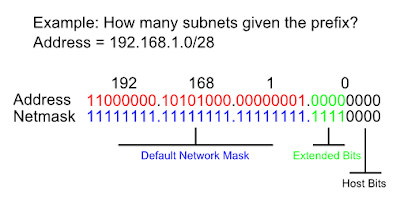- October 28, 2015
- Posted by: Syed Shujaat
- Category: Uncategorized
No Comments
Subnet : is a classful network.
Rules of Subnetting
- Contains set of consecutive numbers (11111111.00000000)
- Holds 2^H (# of host bits) defined by Subnet Mask.
- Can’t use two special numbers in range of IP addresses
- First lowest number = Subnet ID = Subnet Identifier
- Last (Highest number)= Subnet Broadcast address
Subnet ID = Resident Subnet
Note : Prefix (/P) = N + S, / CIRD notation (Classless Ineter Domain Routing)
Subnet = 2^n(Extended bits) , for example Class B has N= 24 bits and /18 means = N+2. The number 2 is extended to next octet.
Transmissions:
- Unicast – a single source host sending to a single destination host.
- Example: Src=192.168.1.1, Dst=192.168.1.2
- Broadcast – a single source host sending to all hosts in the network/subnet. Example: Src=192.168.1.1, Dst=192.168.1.255 (more on this address later in the post)
- Multicast – a single host sending to a single group of hosts (IP class D) Example: Src=192.168.1.1, Dst=224.10.10.10.
There are three things I would like you to remember before we delve into subnetting.
Rule 1
- If the host bits in a given IP address are all set to ‘0‘, this is the network or subnet address.
- If the host bits in a given IP address are all set to ‘1‘, this is the broadcast address (all hosts in the subnet/network are destination).
Rule 2
The formula used to calculate the number of available subnets given the specific length of network mask.
Number of Subnet Calculation – Formula.
Rule 3
The formula used to calculate the number of available hosts per subnet or network given the specific network mask.
Number of Hosts Per Network/ Subnet – Formula.
If you do not remember the ‘first octet rule’, which determines the class and the default network mask of an IP address, use the following table as the reference. The number ranges of the first byte determine the classes
Classful Address Table.
Network (classful) Addresses and Subnet Addresses (classless).
In order to determine the number of subnet bits to use them as the exponent in the above formula , you must first know what is the default network mask of the IP address according to its class . Then, you must count the bits that were added to this default network mask. These bits allow a number of subnets to be created as per formula in pic. 1. Check out the below example.
Pic. 5 – Number of Subnet Bits (Example).
In the example (pic. 5), IP address belongs to class C since the first byte value is 192 (compare it with pic. 3). Class C uses first three bytes (24 bits) to denote the network portion of the address.
Today we can say that its default network mask has the length of 24 bits (255.255.255.0). Since our network mask length is /28, we have extended the default network mask by 4 bits (bits in the green color). Thus, we get 4 subnet bits that must be used in our formula presented in pic. 1.
Pic. 6 – Number of Subnets Available – Calculation.
Using the same example: 192.168.1.0/28, how many host addresses per subnet can we use?
Pic. 5 shows us that with /28 we have 4 bits left for host (total number of bits = 32). In order to calculate the available number of host addresses we must resort to formula presented in pic. 2.
Pic. 7 – Number of Hosts Available – Calculation.
Make sure you understand how the three rules presented here work. In my next post, I’m going to show you how to use them to calculate the subnets based on different criteria such as:
- Number of subnets per IP address
- Number of hosts required in the subnet
- Number of desired host per subnet – Variable Length Subnet Masking (VLSM)
Leave a Reply
You must be logged in to post a comment.







